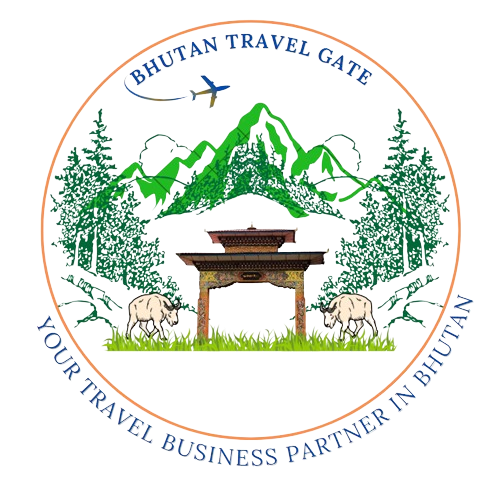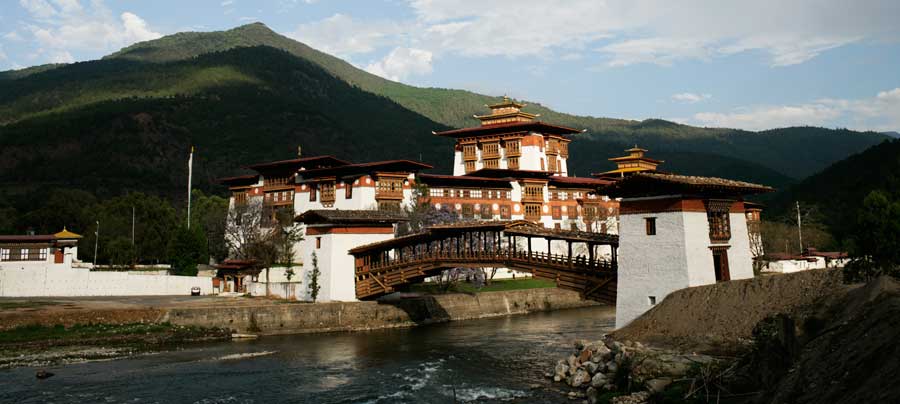Places to visit in Bhutan
Bhutan is divided into Central, Western, Eastern Southern region. Most popular places to visit in Bhutan are Central & Western.

Bhutan is a holy kingdom with deeply spiritual people. Buddhism and Hinduism are both practiced although the majority of the people are Buddhists.
There are more than 10000 stupas or chortens and more than 2000 monasteries in the kingdom, many built centuries ago in honor of the teachings of Buddhism. Some are national treasures like the Taktsang, Tigers Nest built on a sheer craggy cliff face as if grounded on the faith of its people.
The monastery and stupa that are built on top of the valley, these holly place are stunning to see; many of them are built in traditional design providing shelter to meditation practitioners amidst deep nature.
Spiritual seekers will find numerous spiritual sites throughout Bhutan. Some are within easy reach or a few hours walk, and others require a bit of a trek or climb but it is always satisfying to reach the tops of the numerous monasteries that mark Bhutans landscape and to take a moment to contemplate on top of the world.
The Tshechus/festival, local community festivals and the sacred architecture represented by the various stupas and Mani walls, are a constant reminder that in Bhutan, spirituality is still a way of life despite a fast changing world.
Western Bhutan
People of the western region are known as Ngalops descendants of Tibetan immigrants who arrived in Bhutan during 9th Century. Some of the tours includes like Bhutan tour for 7 days that will cover Western Bhutan.
Thimphu is the capital city of Bhutan with a total population of 120000 people. Thimphu became the capital in 1961 after national highway was built which connects Phuntsholing in south which shares border with India to Thimphu. It is about an hour and half drive from the airport in Paro.

Tashichho-Dzong-(Autumn)
Famous places to visit in Thimphu include Buddha Dordenma statue in Kuensel Phodrang, Its one of the largest statue of Buddha in the world with 51.2 m (169 feets) in height and can also do one hour hike from Buddha point to Changangkha, a monastery mainly for the new born baby. And other places are the folk heritage museum, the Tashichho dzong, the vegetable market, market full of local produce and handicrafts, the textile museum, Memorial Stupa which is dedicated to third king of Bhutan, His majesty the King Jigme Dorji Wangchuck.
Thimphu district stretches beyond the town and goes till the Dochula la pass, this pass has 108 Druk Wangyel stupa on a hill and monastery on top of the hill tells the story of our fourth king, King Jigme Singye Wangchuk. On a bright day, you can see the panoramic view of the Himalayan Mountain.
Paro valley is the entry point for all visitors coming to Bhutan on the national carrier, Druk Air and Bhutan airlines.

Tiger-Nest-Monastery
Interesting places to see in Paro include the national museum housed in a round fortress called the Ta dzong and Paro Dzong which function as administrative office of Paro district and other places include Drugyel Dzong , a 17th century fortress at bay, destroyed in fire in 1951 and is under construction right now.
Taktsang (Tiger Nest) is one of the popular and iconic spiritual sites. It is a short day hike of 1.5 hours to 2 hours to the top.
Punakha is the ancient capital of Bhutan, about 2 and half hours drive from Thimphu across Dochula pass. Once you cross the pass, you have to climb down into a warm fertile valley and meander along a gently flowing aquamarine river that leads you to the Punakha Dzong, the second oldest dzong to be built in Bhutan.

Punakha-Dzong
Built in 1637, the dzong continues to be the winter home for the clergy, headed by the chief abbot, the Je Khenpo. It is a splendid example of Bhutanese architecture, sitting at the fork of two rivers, portraying the image of a primitive city from a distance. The Dzong was destroyed by fire and glacial floods over the years but has been carefully renovated and is, today, a fine example of Bhutanese craftsmanship.
Punakha is a subtropical valley where food grains, vegetables and fruits grow in lavishness.
A short drive up the valley is the Khamsum Yulley Chorten, constructed in 1992, as one of three such chortens in the world, one being the National memorial Chorten in Thimphu.
To the south of Punakha is the valley of Wangduephodrang as the national highway heads towards central Bhutan. The old town, a narrow street with single storied shops, will soon be replaced by a brand new town caved out of terraced rice fields.
Wangduephodrang Dzong sits majestically on a steep ridge overlooking the highway that fork to the east and south of the country.
As the road heads towards Central Bhutan known as Trongsa, a turn off below Pelela pass takes you into the magical valley of Phobjikha, home to the rare Black-necked Crane that has been refer Phobjikha as winter home for Black-necked Crane for centuries. The birds fly in from Tibet in October and nonmember and leave before spring.
Another Significant landmark in Phobjikha is the famous Gangtey Goenpa monastery, built in the 17th Century.
Central Bhutan
About four hours drive from Wangduephodrang is the central District of Trongsa, the ancestral home of Bhutans Royal Family and from where the first two kings ruled the Kingdom. This 13-days-holiday-to-bhutan will cover Central and Western Bhutan.

Trongsa-Dzong
Before you reach it, you see the magnificent view of Trongsa Dzong in the valley center. Its labyrinth of temples, corridors, offices and living quarters for the monks add up to a masterpiece in Bhutanese architecture restoration in 2004.
Trongsa is convenient place to halt for the night if you are travelling to the east or the south of Bhutan.
The Trongsa Tshechu (festival) usually falls between late November and mid-December.
Bumthang which is located in Central part of Bhutan is often known as the spiritual heartland of the Kingdom. There are many monasteries and spiritual places in this fascinating Bumthang valley where history and mythology assistance to bring alive much of Bhutans culture and traditions. Bumthang is a picturesque valley of beautiful traditional houses, and fields of buckwheat, barley and apples.

Jakar-Dzong
A strong believe by the public in spiritual diffuses the atmosphere during the auspicious times of the year The valley echoes with the chants of the spiritual community as temples all over offer prayers for the well-being of all the sentient beings.
Some of the famous and important temples include Kurjey Lhakhang (associated with Guru Rinpoche, who brought Tantric Buddhism to Bhutan and Tibet), Jambay Lhakhang and historic Jakar Dzong.
Bumthangs Tshechus/festivals are well known and even its small local festivals are a privilege to attend to catch an insight of the culture and spirit of Bhutan.
Eastern Bhutan
In the east, are Scharchops, widely believed to be the original inhabitants of the country? For those who want to do eastern Bhutan tour will be quite different unlike Western Bhutan tour. This are the area where people speak their own language known as Sharchops and cherish their own culture and weave beautiful textiles.
Trashigang, the largest district of Bhutan, is a 3.5 hour drive from monger and 547 km from Thimphu. The historic Trashigang Dzong, atop a vertically hill above the Sherichu river, is a fine example of the strategic role that these monastic fortresses played in keeping enemies out in ancient times.
The Trashigang town has smartly stretched up the steep mountainside to provide basic necessities for the large population that comes long distances to shop here.
We have to drive for half and hours from Trashigang town to reach Kanglung which is a new town that has grown around the countrys only college, offering undergraduate degrees to about 1000 students in different fields.
A 3.5 hour drive from Trashigang is Trashi Yangtse, the eastern home of the Black necked crane, bordering the Indian district of Arunachal Pardesh. Both Bhutanese and local tribes from across the border of India enjoy the festival of Chorten Kora at Trashi Yangtse.

Tashiyangtse
The Southern Region
To the South are the Lhotsampa. Largely descendants of immigrants from the Nepal who settled in Bhutan in the 19th Century.
Samdrup Jongkhar is a small border town located at Southeastern of Bhutan and its six hours drive from Trashigang. It is one of the entry point for tourist those who are entering Bhutan by road and it connect to Assam state of India.
This district is ideal for bird watcher because weather here is generally warm.
Phuntsholing lies in the southwest of Bhutan and its second largest cities of the country. A busy industrial town is also one of the entry point for the tourist which connect West Bengal state of India
The drive from Phuntsholing to Thimphu that makes the journey worthwhile as the highway takes you on a slow journey from the tropical plains through changing vegetation up to the higher altitudes of the Himalayan Kingdom.
Bhutanese meals are categorized by the hot chili pepper and cheese; put them together and you have the national favorite dishes known as Ama Datshi (literally chili and cheese). This main dish has spun into numerous variations: Kewa Datshi (potato and cheese), Shamu Datshi (mushroom and cheese). These would be normal available in most Bhutanese restaurants.
The very popular dumpling, or the momo is a general favorite and is available either as cheese momo or minced meat. Buckwheat pancakes and noodles substitute rice as the favorite staple in Bumthang


Comment (0)